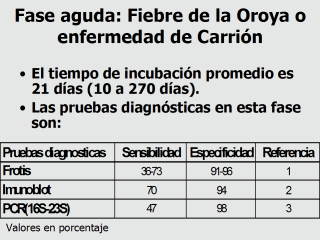| front |1 |2 |3 |4 |5 |6 |7 |8 |9 |10 |11 |12 |13 |14 |15 |16 |17 |18 |19 |20 |21 |22 |23 |24 |25 |26 |27 |28 |29 |review |
 |
La tasa de
mortalidad en pacientes no tratados excede el 40% pero alcanza alrededor del
90% cuando ocurren infecciones oportunistas con Salmonella spp. En un reciente estudio, la tasa de ataque fue 13.8% (123 casos) y la tasa de fatalidad fue 0.7%. Clasicamente, el tratamiento de primera elección ha sido cloramfenicol 10 mg/kg/dia por 10-14 dias. Sin embargo Bartonella bacilliformis es sensible a muchos antibióticos, incluyendo quinolonas. Sobraques M, Maurin M, Birtles RJ, Raoult D. In vitro susceptibilities of four Bartonella bacilliformis strains to 30 antibiotic compounds. Antimicrob Agents Chemother 1999; 43:2090-2. 1. Ellis B, Rotz L, Lake J, Samalvides F, Bernable J, Ventura G, Padilla C, Villaseca P, Beati L, Regnery R, Childs J, Olson J, Carrillo C. An outbreak of acute bartonellosis (Oroya fever) in the Urubamba region of Perú, 1998. Am J Trop Med Hyg 1999; 61: 344-349. 2. Mallqui V, Speelmon E, Verastegui M, et al. Sonicated diagnostic immunoblot for bartonellosis. Clin Diagn Lab Immunol 2000; 7:1-5. 3. Henríquez C, Infante B, Merello J, Maguiña C, Guerra H, Samalvides F, Montoya M, Birtles R, Ventosilla P. Sensitivity and specificity of diagnostic tests for Bartonella bacilliformis in rural population of peruvian andeans. Diagostico(in press). |